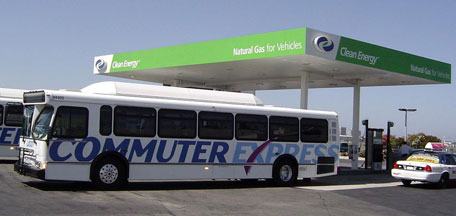Natural Gas Fleets


In contrast to light weight vehicles, heavier vehicles such as trucks and buses are impractical to power with electricity, because they are too heavy and the weight to power ratio is too big. You can't run an 18-wheeler on batteries. Therefore, the most viable alternative to petroleum fuels, gasoline and diesel, for medium and heavy weight vehicles is natural gas.
Another factor that makes natural gas the best alternative fuel for heavier vehicles is that they are mostly owned by fleet operators. Therefore, if CNG fueling stations are scarce, fleet operators can install their own CNG fuel pumps at depots where maintenance is already centralized. As light weight NGVs become more popular, these depots could sell CNG to the general public.
Because heavy long haul trucks operate far from their home bases, they aren't suited to CNG, especially where CNG stations are relatively scarce, such as in the US. Therefore liquid natural gas (LNG) is more practical than CNG for over-the-road trucking, because so much more gas can be stored in a small volume enabling them to travel further without stopping to refuel. Still, LNG powered trucks have to refuel sometime, so trucking companies could install their own LNG stations along major shipping routes.
Fleets of medium and heavy weight NGVs could radically reduce foreign oil dependence. For example, in the US there are about 2 million big rig trucks which use about 25% of its oil imports, and switching them to natural gas would be a huge dent in foreign oil dependence. Other heavier vehicle fleets that could run on CNG include delivery trucks and vans, garbage trucks, transit and school buses, shuttle services, construction vehicles like bulldozers, and farm equipment (both for large farms and co-ops of small farms). Operators of light weight vehicle fleets could also replace gasoline and diesel vehicles with NGVs including taxis and municipal public works vehicles.
Concentrate on producing natural gas vehicles (NGVs) for fleets, especially fleets of medium and heavy duty vehicles like trucks and buses. Install CNG fuel pumps at the fleet depots, and LNG stations along major long haul trucking routes.